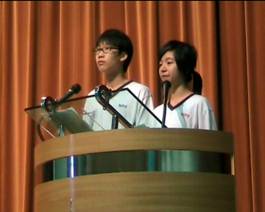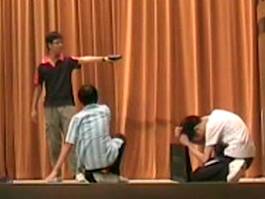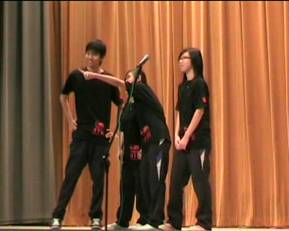| Background Teachers are concerned about how they can promote a smoother interface between junior and senior secondary levels. They would like to infuse language arts into the school-based English Language curriculum at Key Stage 2. It is also hoped that Language Arts would enhance students' confidence in their English skills and motivation in learning English.
The infusion mode is adopted in the module design, with Language Arts materials supplementing the textbook unit 'Going Places', so that there would be a more gradual change for both teachers and students. In the module, students are exposed to various types of poems, drama activities and a song. Then they try to produce their own Language Arts texts afterwards, which will be kept in their Language Arts portfolios for formative assessment. The drama activities conducted in class prepared students for the school's drama competition, establishing a link between the formal and informal curricula.
|
| |
| Objectives
The module aims…
- to expose students to different Language Arts text types, namely poetry, songs and drama, to stretch their appreciation ability;
- to develop students' imagination and creativity by creating their own Language Arts texts;
- to motivate students in learning English through Language Arts;
- to help teachers better prepare for the NSS curriculum; and
- to nurture the culture of adopting formative assessments.
|
| |
Implementation
Textbook chapters: |
Module: In and Around Hong Kong
Unit: Unit 5 Going Places |
Language Focus |
Prepositions
Connectives of reasons and results |
Product: |
A Language Arts Portfolio to enhance assessment for learning. |
Lesson 1-2
Procedure |
Resources |
- Teacher introduces the title of the module, the text types students will learn in the module, as well as the concept and aim of the Language Arts Portfolio to students.
- Students write an *Acrostic poem for the cover page of the portfolio with their names.
- Students set *learning goals for themselves in this module.
|
|
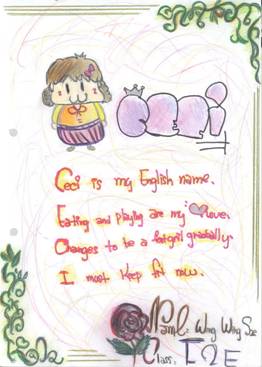
|
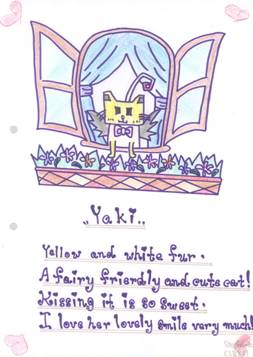
|
Students' work |
Lesson 3
Procedure |
Resources |
- Students sing and learn about -*the song 'I like Hong Kong' as a lead-in activity.
- Students learn about the names of places in Hong Kong in a naming game. They then refer to the textbook for listening practice and consolidation.
|
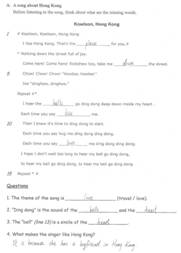
Students' work
|
Lesson 4 - 5
Procedure |
Resources |
- Teacher introduces shape poems to students for appreciation purpose. Students learn about the features of shape poems.
- Students are guided to write *a shape poem about a place in Hong Kong.
|
|
Students' work |

|
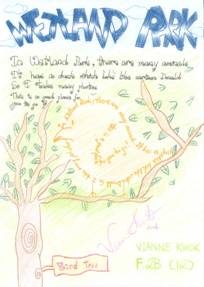
|
Lesson 6 - 9
Procedure |
Resources |
- Teacher goes over the reading comprehension passage in the textbook with the students.
The 'Slap and Escape' Game
- In pairs, students stretch out their arms in their front, facing their partners.
- With one palm facing up and the other facing down, their goal is to slap their partners with one hand while escaping from their partners' slap at the same time.
- Teacher reads out an excerpt of the comprehension text. When students hear the targeted language items (prepositions / connectives of reasons and results), they need to slap and escape.
- After each round, students record their score in the score sheet.
- Students have to learn the importance of concentration in performing drama.
- Students complete the * reflection sheet on drama activities.
Find the partner game
- Some students are chosen and each student is given a dialogue card. They practise their voice projection by reading their lines clearly until they find their partners.
- Teacher explains to students the importance of projecting our voice when speaking, especially in drama.
- Students complete the * reflection sheet on drama activities.
|
|
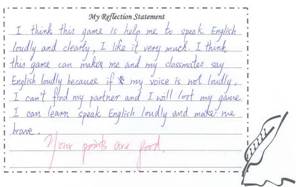
Students' work
|
Lesson 10 - 11
Procedure |
Resources |
- Students complete listening exercises in the textbook.
Find the answer game
- Teacher chooses 12 students who are quite confident in speaking and gives each of them a card.
- On each card, there is a line of a dialogue with emotions indicated. The 12 students have to read out the lines with the indicated emotions one by one.
- The rest of the students have to guess which pairs of students are expressing the same emotions.
- Teacher rounds up and explains that the rising/falling tones, the fast/slow pace, the loudness/softness of our voice would all affect the meaning of our speeches.
- Students complete the * reflection sheet on drama activities.
|
|
Lesson 12
Procedure |
Resources |
- Before reading the poem 'Pearl of Orient, teacher shows pictures that correspond to the similes in the poem.
- Teacher elicits from students what the objects in the pictures look like and introduces the concept of simile.
- Teacher introduces each stanza of the poem with picture illustrations and elicits from students the similes used in the poem.
- Teacher distributes *a worksheet to students.
- Students need to think about the special features of a place in Hong Kong and write similes about it.
|
|
Lesson 13-18
Procedure |
Resources |
- Students learn about drama script features and format.
- Students work in groups of four to write *a short drama script based on a story synopsis. Teacher checks whether students understand the features of drama scripts in the students' work.
- Students are given a worksheet with a situation and a blank 4-square comic strip
- In pairs, students respond to the situation and compose a funny/exciting story in the format of *a comic strip - brainstorming for a story about tourists in Hong Kong.
- Before students start writing, a *mark sheet with all assessment criteria is given and explained to them.
- Students start writing *the drama script. They may need to be reminded of the drama script features from time to time.
- Teacher monitors students' progress and reminds them to refer to the assessment criteria from time to time.
- Students complete *a self-reviewing checklist to self-assess their writing.
- Teacher collects the scripts, mark sheets and self-reviewing checklists for assessment.
|
|
Students' work |
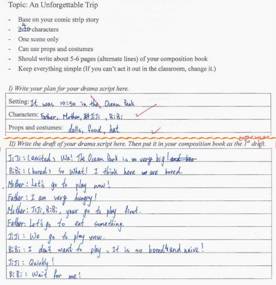
|

|
*Items to be put in the Language Arts Portfolio.
Extension – Inter-class drama competition
|
| |
Acknowledgements
- Miss Chan Wai Fan, Mandy
- Miss Cheung Wai Shan, Eveline
- Mr. Lui Siu Chung
- Miss Tam Hoi Yee, Hidy
- PHC Wing Kwong College
|
|








